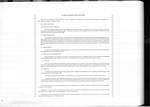|
|
 |
 |
AUSCHWITZ:
Technique
and Operation
of
the Gas Chambers © | |
|
| |
 |
Back |
 |
Contents |
Page 66 |
 |
Home
Page |
Forward |
 |
| |
| US ARMY DISINFESTATION
METHODS |
| |
| Extracts from the "MEDICAL FIELD MANUAL: FIELD
SANITATION" published by the United States War Department.
Washington D.C. 1940, taken from chapter 9 "Control of
lice" |
|
"168: CONTROL MEASURES:
(2) Disinfestation of
clothing and equipment.
b.
Lice and their eggs are killed in one minute when subjected to dry
heat at a temperature of 155°F [68°C] or in five minutes at 131°F
(55°C], immersion in boiling water for thirty seconds will kill
both adults and eggs. Dry heat will not injure leather, felt, or
webbing but will harm woollen fabrics. Boiling water will cause
shrinking of wool but steam causes very little shrinkage.
171: MOBILE DISINFESTORS:
These are of the four-wheel
trailer type and are usually steam pressure disinfestors although
a current steam disinfestor is manufactured (thresh type). The
pressure type consists of a horizontal steam chamber around which
there is an outer jacket which is assembled as a unit with a
boiler, After the clothing is placen in the disinfestor a vacuum
of 10 to 15 inches [254 to 381 mm of Mercury] is created after
which the steam is turned on until a positive pressure of 15
pounds [6.8 kg] is attained [corresponding to a water temperature
of 165 °C], this being held for about twenty minutes. At the end
of this time the steam is released and a vacuum of 10 to 15 inches
is produced in order to dry the clothing. This vacuum is held for
about five minutes. Clothing should be placed loosely in order
that the steam may penetrate.
172: SERBIAN BARREL:
a. (Summary) here clothes
placed in a galvanised garbage can or similar with wire mesh in
the bottom are disinfested by having steam from boiling water
underneath passed through them for forty five minutes.
173: IMPROVISED HOT AIR DISINFESTORS:
Clothing and equipment may be
placed in ovens, boxes or cans and subjected to dry heat. Small
buildings or dugouts may be converted into hot air disinfestors by
installing heating apparatus which will heat the air to
160°F(71°C]. Clothing should be hung loosely and exposed for about
thirty minutes.
175: HOT WATER:
Cotton, linen or silk
clothing maybe disinfested by immersion in boiling water for one
minute Or in water having a temperature of 135°F [57°C) or more
to) live minutes. In order to disinfect as well as disinfest, the
clothing should be subjected to a temperature of at least 160°F
[71°C] for fifteen to thirty minutes. Woollen clothing can be
disinfested by this process, but considerable shrinkage will
occur. Leather, felt or webbed articles are damaged by exposure to
hot water.
177. CHEMICALS:
a. Chemicals such as acetic
acid (vinegar), kerosene, gasoline, cresol or naphthalene may be
applied to the person or clothing of the infested individual. Most
of these substances will not kill the eggs however.
b. (Summary) a 5% solution
of cresol in water or a 2 % solution that can be maintained at a
temperature of about 100°F [38°C] for thirty minutes.
c. (Addendum of December
1943): Methyl bromide bag fumigation using a special bag already
containing an ampule of 20 cc. The time of exposure varies
according to the temperature of the clothing: at 55°F (13°C] or
above, three quarters of an hour. For each 10° [5-6°] drop below
55°F, half an hour is added to the fumigation period, giving one
and a quarter hours at 45° F (7°C). one and three quarter hours at
35°F [2°C] and two and a quarter hours at 25°F [-4°C)."
|
These extracts from the US Army recommendations on field
sanitation show the different delousing methods that can be used
according to the effects to he disinfested.
Paragraph 171
makes it possible to undersand the working of the three autoclaves
in the Birkenau Zentral Sauna and the function of the two gauges
fitted on the southern doors: one for temperature, the other for
pressure.
The principle of methyl bromide bag fumigation is
that of a small gas chamber. In Auschwitz, the bag became a brick or
concrete gas-tight room and the delousing agent was hydrocyanic
acid. | |
| |
AUSCHWITZ:
Technique
and operation
of the gas chambers
Jean-Claude Pressac
© 1989, The
Beate Klarsfeld Foundation |
 |
Back |
Page 66 |
Forward |
 |
|

